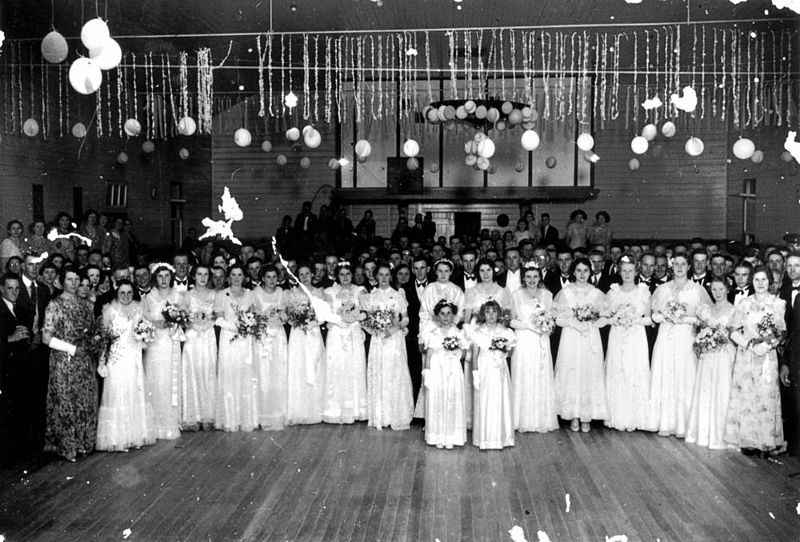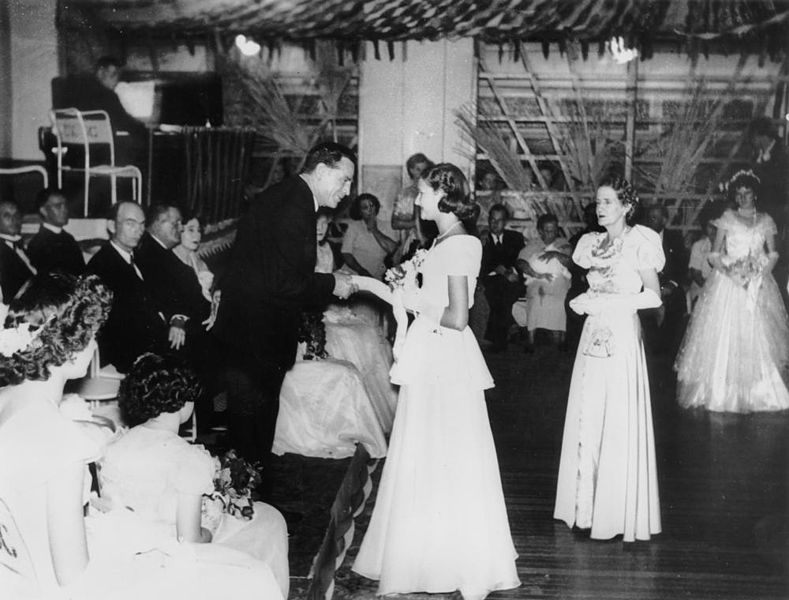I Spent 4 Years Working at Drunken, Decadent Debutante Balls in New Orleans
 A debutante ball in the 1930s. (Photo: Public Domain/WikiCommons)
A debutante ball in the 1930s. (Photo: Public Domain/WikiCommons)
“I’m deeply reconsidering my career choice,” a distraught fellow lighting designer tells me. It’s 5 a.m. on the morning of a massive society ball in New Orleans. In just a few hours the room will fill with young girls in white princess gowns and old men in tuxedos.
By that evening, everyone who is not an underage debutante will be spilling their wine, taking out entire table garnishes and injuring themselves on the dance floor as I watch it all from a spotlight tower.
In New Orleans, debutante balls and cotillions are usually held in elaborately styled ballrooms in fine hotels facing the Mississippi River. These events are like senior proms turned up to 11, but with grandparents and prancing stallions invited along for the ride. The design aesthetic for many balls resembles a particularly gaudy stage set of “A Midsummer Night’s Dream.” Crystal-encrusted ball gowns are not uncommon.
These celebrations are the high point of society season in many moneyed Southern enclaves. But behind every blow-out cotillion and debutante ball is a production crew working to ensure that all the weirdness goes smoothly–or as smoothly as it can possibly go when most attendees are drinking very, very heavily.
 A view from the spotlight tower. Photos of the events are discouraged. (Photo: April Siese)
A view from the spotlight tower. Photos of the events are discouraged. (Photo: April Siese)
I’ve worked in lights and audio at debutante balls for four years. When I arrive, I’m handed a detailed script that usually includes the evening’s program as well as biographies about each young socialite making their debut, which I will read out in a very serious voice while trying not to giggle when their “carriages” are assessed, like prize racehorses.
At their briefest, the descriptions run around two to three sentences. It’s usually the youngest girls, aged 11 or 12, making their first excruciatingly slow walk around the narrow pathway lined by society royalty that get the shortest spiel. The longest introductions, for college-age debs, drag on for pages and pages, detailing everything from the person in question’s hopes and dreams to their hobbies.
The balls perpetuate a slice of old New Orleans high society that is avidly covered by the local newspapers; the Times-Picayune actually published short profiles and photos of each of this year’s 65 debs. Beautillion balls–the male equivalent of the archaic pageantry–are few and far between.
I’ve seen five-man teams holding up trains of heavy dresses, or frantically working to set up garish thrones that probably cost more than the rest of the entire event. Extensive, ineffective stage set-ups are just as common, with bands vying for the drunken attention of guests as fervently as if they were playing for tips and not a hefty appearance fee.
 Hotels by the river in New Orleans, including the Hilton (far left), often host the balls. (Photo: InfrogmationofNewOrleans/flickr)
Hotels by the river in New Orleans, including the Hilton (far left), often host the balls. (Photo: InfrogmationofNewOrleans/flickr)
As for me, I’m usually off to the side in a spotlight tower, armed with only a headset and a spotlight. This presents its own problems when attendees get too rowdy. I’ve had my scaffolding rocked hard enough to send objects flying to the ballroom below and the folds of my scissor lift impaled by empty wine bottles. It’s pretty hard to come down from this perch without crunching glass, but no one seems to notice or care since there’s a fine layer of black fabric masking the machinery.
At the height of my job duties, I am programming the lights we’ve arranged and calling the show as it progresses. We’re given walkie talkies in order to stay in contact with the society belles who are calling the real shots, but most of them would rather make endless loops around the tables than talk to the “hired help.” We generally make it up as we go along, as drunken debutantes have a fairly high tendency of going rogue. The parties and our job duties in between can drag to 18 hours or more.
I’ve heard “Monster Mash” followed by “A Christmas Song” requested to end a ball, the house band confused but amiable. Trios of drunk women have followed me to bathrooms in the bowels of hotels because they were too plastered to find the facilities just outside the ballroom. I’ve witnessed full meltdowns with suit-clad men falling over on broken chairs and lamenting god knows what while harried carpenters pull pallet jacks filled with set pieces through to a loading dock at 4 a.m.
 Debutantes in Australia in 1953. (Photo: Public Domain/WikiCommons)
Debutantes in Australia in 1953. (Photo: Public Domain/WikiCommons)
I’ve been tipped $20 to slow dance with a drunken, sweaty father of a debutante to Michael Jackson’s “PYT” because I’d just hopped off my spotlight tower and happened to be within his line of sight. I’ve acted as an impromptu security guard when guests deemed the band not energetic enough and attempted to rush the stage with their own requests for songs and special frenetic dance moves in mind. I’ve certainly lost track of the crying, punch-drunk attendees seeking purses and handbags after their nights had escaped from their silken gloved grasps.
The meltdowns aren’t exclusive to the socialites we cater to, of course. That same lighting designer panicking about his profession has had to talk down fellow crew members when things have gone perilously wrong. I’ve been on the other side of the phone helping a coworker troubleshoot on the morning of the biggest ball in the city. But each time I’d give advice, a Marine Band practicing in the background would blare their horns loud enough to fill the Superdome, rendering conversation impossible.
Predictably, as soon as we had hung up the phone, the band dispersed and all was silent until the red carpet rolled out and the royalty filed in.













Follow us on Twitter to get the latest on the world's hidden wonders.
Like us on Facebook to get the latest on the world's hidden wonders.
Follow us on Twitter Like us on Facebook